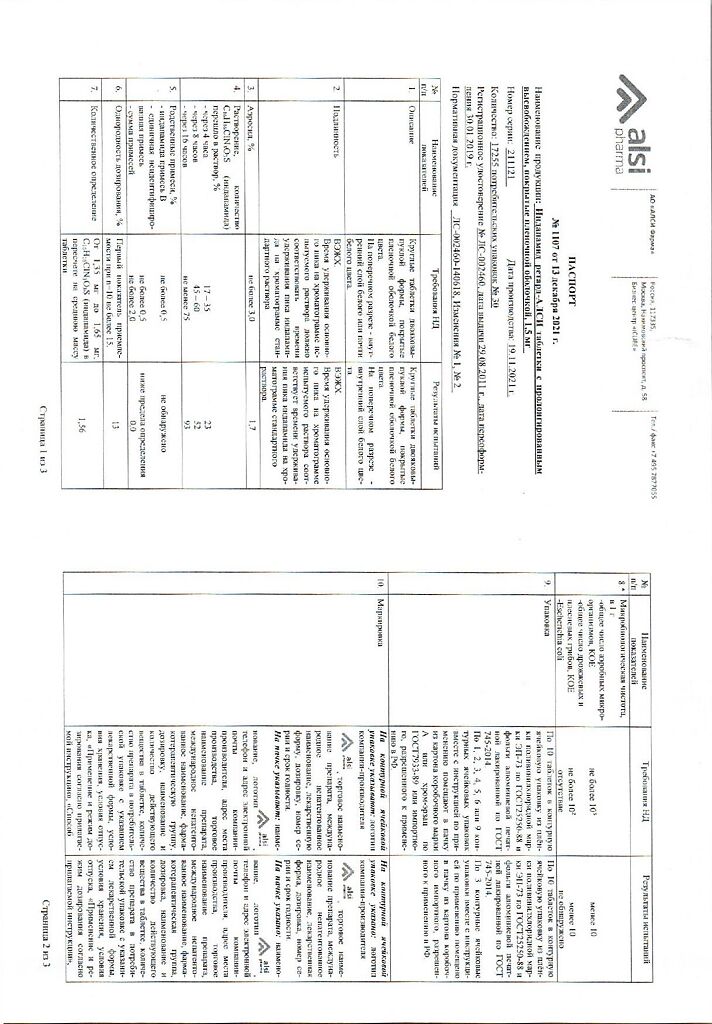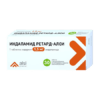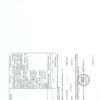No products in the cart.
Indapamide retard-ALSI, 1.5 mg 30 pcs
€2.52 €2.00
Out of stock
(E-mail when Stock is available)
Description
Hypotensive agent, thiazide-like diuretic with moderate potency and long duration of action, benzamide derivative. It has moderate saluretic and diuretic effects associated with blockade of reabsorption of sodium, chloride, hydrogen and, to a lesser extent, potassium ions in the proximal tubules and cortical segment of the distal tubule of the nephron.
Vasodilator effects and reduction of total peripheral vascular resistance are based on the following mechanisms: reduction of reactivity of the vascular wall to noradrenaline and angiotensin II, increased synthesis of prostaglandins, having vasodilator activity, inhibition of calcium ions flow in vascular smooth muscle walls. Reduces the tone of arterial smooth muscle, reduces total peripheral vascular resistance.
Contributes to the reduction of left ventricular hypertrophy. In therapeutic doses does not affect lipid and carbohydrate metabolism (including in patients with concomitant diabetes).
Indications
Indications
Arterial hypertension.
Pharmacological effect
Pharmacological effect
Antihypertensive drug, thiazide-like diuretic with moderate strength and long-lasting action, benzamide derivative. It has moderate saluretic and diuretic effects, which are associated with blockade of the reabsorption of sodium, chlorine, hydrogen ions, and to a lesser extent potassium ions in the proximal tubules and the cortical segment of the distal tubule of the nephron.
Vasodilating effects and a decrease in total peripheral vascular resistance are based on the following mechanisms: a decrease in the reactivity of the vascular wall to norepinephrine and angiotensin II; increased synthesis of prostaglandins with vasodilatory activity; inhibition of the flow of calcium ions into the smooth muscle walls of blood vessels. Reduces the tone of the smooth muscles of the arteries, reduces the total peripheral vascular resistance.
Helps reduce hypertrophy of the left ventricle of the heart. In therapeutic doses it does not affect lipid and carbohydrate metabolism (including in patients with concomitant diabetes mellitus).
Special instructions
Special instructions
Liver dysfunction. In patients with liver failure, when thiazide-like diuretics are prescribed, hepatic encephalopathy may develop, especially if the water-electrolyte balance is impaired. If it develops, diuretics should be discontinued.
Photosensitivity. When using thiazide-like diuretics, cases of photosensitivity reactions have been reported. If they develop, the drug should be discontinued. During therapy with Indapamide retard, it is necessary to protect exposed areas of the body from exposure to sunlight and artificial ultraviolet radiation.
Water and electrolyte balance. Content of sodium ions in blood plasma: all diuretics can cause hyponatremia. The content of sodium ions in the blood plasma should be measured before starting treatment with Indapamide retard, and then regularly during the treatment period. Determination of the content of sodium ions in the blood plasma must be carried out before starting therapy with Indapamide retard, as well as during the period of therapy. It is important to regularly monitor the content of sodium ions in the blood plasma, because Initially, hyponatremia may be asymptomatic. The most careful monitoring of sodium ion levels is indicated for elderly patients and patients with liver cirrhosis.
Content of potassium ions in blood plasma: the greatest risk during treatment with thiazide-like diuretics is hypokalemia. Particular attention should be paid to the prevention of hypokalemia (less than 3.4 mmol/l) in the following cases: debilitated patients and/or those receiving other therapy (antiarrhythmic drugs and drugs that can prolong the QT interval on the ECG), the elderly, patients with cirrhosis, peripheral edema and ascites; with coronary heart disease and chronic heart failure. Hypokalemia in such patients increases the toxic effect of cardiac glycosides and increases the risk of developing arrhythmia. Patients with a prolonged QT interval on the ECG are also at increased risk. Hypokalemia is a predisposing factor in the occurrence of severe arrhythmias, and especially torsade de pointes, which can be fatal. In all the described cases, it is necessary to regularly monitor the potassium content in the blood plasma. The first determination of potassium in the blood plasma should be carried out during the first week of therapy with Indapamide retard.
If hypokalemia is detected, appropriate therapy should be administered.
Content of calcium ions in blood plasma: thiazide-like and thiazide diuretics can reduce the excretion of calcium ions by the kidneys, leading to minor and/or temporary hypercalcemia. Severe hypercalcemia while taking the drug Indapamide retard may be a consequence of previously undiagnosed hyperparathyroidism.
Diuretics should be discontinued before testing parathyroid function.
Plasma glucose concentration: in patients with diabetes mellitus, especially in the presence of hypokalemia, monitoring of plasma glucose concentration is necessary.
Uric acid: in patients with hyperuricemia, may increase the frequency of attacks or exacerbation of gout.
Renal function and diuretics. Thiazide and thiazide-like diuretics are fully effective only in patients with normal or slightly reduced (plasma creatinine in adults less than 25 mg/l or 220 µmol/l) renal function. Severe hypovolemia can lead to the development of acute renal failure (decreased glomerular filtration rate), which may be accompanied by an increase in the concentration of urea and creatinine in the blood plasma. With normal renal function, transient functional renal failure usually resolves without consequences. If there is existing renal failure, the patient’s condition may worsen.
Elderly patients: Regular monitoring of creatinine concentrations and potassium levels in the blood plasma is recommended, taking into account the patient’s age, body weight and gender. Indapamide retard can be prescribed to elderly patients with preserved or slightly impaired renal function (creatinine clearance above 30 ml/min).
Athletes. Indapamide retard may give a positive result during a doping control.
Impact on the ability to drive vehicles and other complex mechanical means. The use of indapamide retard does not lead to impairment of psychomotor reactions. However, some patients may develop different individual reactions in response to a decrease in blood pressure, especially at the beginning of therapy or when other antihypertensive drugs are added to the therapy. In this regard, at the beginning of treatment with Indapamide retard, it is not recommended to drive vehicles or other complex mechanisms that require increased attention.
Active ingredient
Active ingredient
Indapamide
Composition
Composition
One extended-release film-coated tablet contains:
as an active ingredient:
indapamide – 1.5 mg;
excipients:
hypromellose – 77.36 mg,
lactose monohydrate (milk sugar) – 119.14 mg,
colloidal silicon dioxide (Aerosil) – 1.0 mg,
magnesium stearate – 1.0 mg,
hypromellose – 2.24 mg,
lactose monohydrate – 2.88 mg,
polyethylene glycol – 0.80 mg,
titanium dioxide – 2.08 mg.
Contraindications
Contraindications
Hypersensitivity to indapamide, other sulfonamide derivatives or other components of the drug, acute cerebrovascular accident, severe renal impairment (creatinine clearance less than 30 ml/min) and/or liver (including with hepatic encephalopathy), hypokalemia, pregnancy, lactation, age under 18 years (efficacy and safety have not been established).
These tablets contain lactose monohydrate (milk sugar), therefore the drug should not be taken by patients with rare hereditary diseases such as lactose intolerance, lactase deficiency or glucose-galactose malabsorption.
With caution. Use the drug with caution in diabetes mellitus, hyperuricemia (especially accompanied by gout and urate nephrolithiasis), hyponatremia and other water-electrolyte imbalances, moderate hepatic and/or renal failure, chronic heart failure, hyperparathyroidism, in patients with an increased QT interval on the ECG or receiving combination therapy, which may result in a prolongation of the QT interval (astemizole, erythromycin (intravenous), pentamidine, sultopride, terfenadine, vincamine (iv), class IA antiarrhythmic drugs (quinidine, disopramide) and class III (amiodarone, bretylium tosylate).
Side Effects
Side Effects
Most adverse reactions (laboratory and clinical indicators) are dose-dependent. The frequency of adverse reactions that can be caused by thiazide-like diuretics, including indapamide, is given in the following gradations: very often (>1/10); often (>1/100, 1/1000, 1/10000, <1/1000); very rare (< 1/10000); unspecified frequency (frequency cannot be calculated from available data).
From the circulatory and lymphatic system. Very rare: thrombocytopenia, leukopenia, agranulocytosis, aplastic anemia, hemolytic anemia.
From the central nervous system. Rarely: dizziness, fatigue, headache, paresthesia.
From the cardiovascular system. Very rare: arrhythmia, decreased blood pressure.
From the digestive system. Uncommon: vomiting. Rare: nausea, constipation, dry mouth. Very rare: pancreatitis.
From the urinary system. Very rare: renal failure.
From the liver and bile ducts. Very rare: liver dysfunction.
Unspecified frequency: possibility of developing hepatic encephalopathy in case of liver failure.
From the side of the skin. Hypersensitivity reactions, mainly dermatological, in patients with a predisposition to allergic and asthmatic reactions: Common: maculopapular rash. Uncommon: hemorrhagic vasculitis. Very rare: angioedema and/or urticaria, toxic epidermal necrolysis, Stevens-Johnson syndrome. Unspecified frequency: possible deterioration in the presence of an acute form of disseminated lupus erythematosus. Cases of photosensitivity have been described.
Laboratory indicators. In clinical studies, hypokalemia (plasma potassium ≤3.4 mmol/L) was observed in 10% of patients and 3.2 mmol/L in 4% of patients after 4-6 weeks of treatment. After 12 weeks of therapy, plasma potassium levels decreased by an average of 0.23 mmol/l. Very rarely hypercalcemia. Unspecified frequency: Hypokalemia; Hyponatremia, accompanied by hypovolemia, dehydration and orthostatic hypotension. The simultaneous loss of chlorine ions can lead to compensatory metabolic alkalosis, however, the frequency of development of alkalosis and its severity is not significant; Increased levels of uric acid and glucose in the blood plasma.
Interaction
Interaction
Not recommended combinations When used simultaneously with lithium preparations, it is possible to increase the concentration of lithium ions in the blood plasma due to a decrease in its excretion from the body by the kidneys, accompanied by the appearance of signs of overdose (nephrotoxic effect), as well as when following a salt-free diet (decreased excretion of lithium ions by the kidneys).
Combinations that require special attention.
1. Drugs that can cause heart rhythm disturbances of the “pirouette” type: class IA antiarrhythmics (quinidine, hydroquinidine, disopyramide), class III antiarrhythmics (amiodarone, dofetilide, ibutilide, bretylium tosylate), sotalol, some neuroleptics: phenothiazines (chlorpromazine, cyamemazine, levomepromazine, thioridazine, trifluoperazine), benzamides (amisulpride, sulpiride, sultopride, tiapride), butyrophenones (droperidol, haloperidol), others (bepridil, cisapride, difemanil, erythromycin (intravenous (IV)), halofantrine, mizolastine, pentamidine, sparfloxacin, moxifloxacin, vincamine (iv), astemizole. Concomitant use with any of these drugs, especially against the background of hypokalemia, increases the risk of ventricular arrhythmias of the “pirouette” type. Before starting combination therapy with Indapamide retard and the above drugs, the potassium content in the blood plasma should be monitored and, if necessary, adjusted. It is recommended: monitoring the patient’s clinical condition, as well as the content of blood plasma electrolytes. and ECG. In patients with hypokalemia, it is necessary to use drugs that do not provoke the development of pirouette-type arrhythmias.
2. With the simultaneous administration of nonsteroidal anti-inflammatory drugs (NSAIDs) (for systemic use), including selective cyclooxygenase-2 (COX-2) inhibitors, high doses of salicylic acid (3 g/day or more), it is possible: a decrease in the antihypertensive effect of indapamide, the development of acute renal failure in dehydrated patients (due to a decrease in glomerular filtration rate). At the beginning of indapamide therapy, it is necessary to restore water and electrolyte balance and monitor renal function.
3. Angiotensin-converting enzyme (ACE) inhibitors in patients with hyponatremia (especially in patients with renal artery stenosis) increase the risk of developing arterial hypotension and/or acute renal failure. Patients with hypertension and possibly hyponatremia due to diuretics should:
– stop taking the drug 3 days before starting therapy with ACE inhibitors and switch to therapy with potassium-sparing diuretics;
– or start therapy with ACE inhibitors with low doses, followed by a gradual increase in dose if necessary. During the first week of therapy with ACE inhibitors, it is recommended to monitor plasma creatinine concentrations.
4. Other drugs that can cause hypokalemia:
– amphotericin B (iv), – gluco- and mineralocorticosteroids (when administered systemically) (see also information in the section “Combinations of drugs that require attention”), – tetracosactide (see also information in the section “Combinations of drugs that require attention”) – laxatives that stimulate intestinal motility.
When taken simultaneously with indapamide, the above drugs increase the risk of developing hypokalemia (additive effect). If necessary, the content of potassium ions in the blood plasma should be monitored and adjusted.
5. Simultaneous therapy with baclofen enhances the antihypertensive effect of indapamide.
6. Cardiac glycosides: hypokalemia increases the toxic effect of cardiac glycosides (glycoside intoxication). With the simultaneous use of indapamide and cardiac glycosides, the content of potassium ions in the blood plasma, ECG parameters should be monitored, and, if necessary, therapy should be adjusted.
Combinations of drugs requiring attention.
1. Simultaneous use with potassium-sparing diuretics (amiloride, spironolactone, triamterene) is advisable in some patients, but the possibility of developing hypokalemia cannot be excluded. Hyperkalemia may develop against the background of diabetes mellitus or renal failure. It is necessary to monitor the content of potassium ions in the blood plasma, ECG indicators, and, if necessary, adjust therapy.
2. Metformin increases the risk of developing lactic acidosis, because It is possible to develop renal failure while taking diuretics, especially loop diuretics. Metformin should not be taken if the plasma creatinine concentration is more than 15 mg/l (135 µmol/l) in men and 12 mg/l (110 µmol/l) in women.
3. The simultaneous use of large doses of iodine-containing contrast agents against the background of hypovolemia and diuretics increases the risk of developing acute renal failure. It is recommended to restore the water and electrolyte balance of the blood before using the drugs.
4. Tricyclic antidepressants (imipramine-like) and antipsychotics increase the hypotensive effect and the risk of developing orthostatic hypotension (additive effect).
5. Preparations containing calcium salts increase the risk of developing hypercalcemia due to a decrease in the excretion of calcium ions by the kidneys.
6. Cyclosporine, tacrolimus – the risk of increasing the concentration of creatinine in the blood plasma without changing the concentration of circulating cyclosporine.
7. Glucocorticosteroid drugs, tetracosactide (when used systemically) reduce the hypotensive effect (retention of sodium ions and fluid).
Overdose
Overdose
Symptoms: nausea, vomiting, weakness, dysfunction of the gastrointestinal tract (nausea, vomiting), water and electrolyte disturbances, marked decrease in blood pressure, dizziness, drowsiness, confusion, respiratory depression, polyuria, oliguria up to anuria; in patients with impaired liver function, hepatic coma may develop.
Treatment: gastric lavage and/or administration of activated carbon followed by restoration of normal water and electrolyte balance, symptomatic therapy. There is no specific antidote.
Recommendations for use
Recommendations for use
Orally, without chewing, with a sufficient amount of liquid, regardless of food intake, mainly in the morning at a dose of 1.5 mg (1 tablet) per day.
If after 4-8 weeks of treatment the desired therapeutic effect is not achieved, it is not recommended to increase the dose of the drug (the risk of side effects increases without enhancing the antihypertensive effect). Instead, it is recommended to include another antihypertensive drug that is not a diuretic in the drug treatment regimen.
In cases where treatment must be started with two drugs, the dose of Indapamide retard remains 1.5 mg in the morning once a day.
In elderly patients, plasma creatinine concentrations should be monitored taking into account age, body weight and gender; the drug can be used in elderly patients with normal or slightly impaired renal function (see also section “Contraindications”).
Functional features
Functional features
After oral administration, the drug is completely but gradually absorbed from the gastrointestinal tract. Bioavailability is high (93%). Eating slightly slows down the rate, but does not affect the completeness of absorption. The maximum concentration in blood plasma is achieved 12 hours after oral administration of a single dose.
Storage conditions
Storage conditions
In a dry place, protected from light, at a temperature not exceeding 25º C. Keep out of the reach of children.
Shelf life
Shelf life
3 years. Do not use after the expiration date stated on the package.
Manufacturer
Manufacturer
ALSI Pharma, Russia
Additional information
| Shelf life | 3 years. Do not use after the expiration date stated on the package. |
|---|---|
| Conditions of storage | In a dry, light-protected place at a temperature not exceeding 25º C. Keep out of reach of children. |
| Manufacturer | ALSI Pharma, Russia |
| Medication form | sustained release tablets |
| Brand | ALSI Pharma |
Related products
Buy Indapamide retard-ALSI, 1.5 mg 30 pcs with delivery to USA, UK, Europe and over 120 other countries.






















